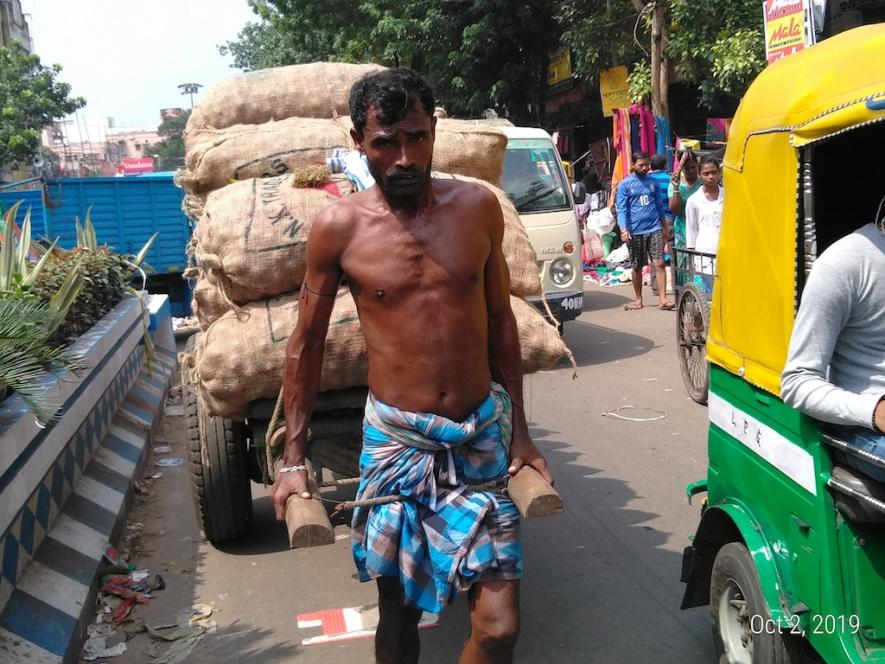Slowdown Casts Shadow on West Bengal’s ‘Puja Economy’

Kolkata: The first leg of the Autumn Festival in West Bengal has just got over with the end of Durga Puja and Bijoya Dashami, pulling the curtains down on one of the world’s biggest ‘street festivals’, which reportedly contributes 10% to the state gross domestic product of Rs 13. 16 lakh crore, as per industry estimates.
However, the shadow of a country-wide economic slowdown, following demonetisation and hasty implementation of goods and services tax, was quite evident during this year’s festivities.
According to industry chamber, Assocham’s report in 2013, West Bengal’s festival economy was set to cross Rs 1.5 lakh crore, but this was before demonetisation and GST. This year, the state has struggled to even reach the Rs 1 lakh crore mark during the festival season so far, as per initial estimates.
Even the budget of the top 15 Durga Puja Committees saw a reduction in absolute terms, while the budget of the small and medium Puja Committee’s was down by over 20%, as per estimates, despite the controversial enhanced largesse of about Rs 75 crore to over 12,000 Puja Committees by the ruling Trinamool Congress (TMC) government. The Left parties had opposed this move to dole out largesse on religious lines.
For Hashubala Soren, 39, and brick loading construction worker, festival times during her childhood meant spending days and nights in the Durga Puja pandal in Jhargram town during the late 1990s. She used to sell ghoogni (a savoury delicacy) along with her father and spent a part of the extra income merry-making after Bijoya Dashami.
This year, Hashubala, a widow since the past five years, worked overtime during the Puja season to earn enough to pay for her daughter’s books. She proudly tells Newsclick that though she lives in a slum at Kalikapur, her daughter goes to an “Ingreji School” “(English medium school).
Hashubala recalled that after her marriage in 2005, at the age of 15, she, who had studied up to Class 9, had shifted base to Kolkata along with her labourer husband, who died while at work in 2014. She says she did not get a single penny of compensation, as the contractor called “Mondal “swallowed the Rs 50,000 provided by the promoters of the apartment where he was working as construction labour.
For Nirmalya Acharya, 49, a contractual security guard living in Ghusri of Howrah, the economic slowdown has finished all his resources, as his previous job with a bearing company in Howrah vanished after demonetisation. At the age of 47, Acharya, an English graduate from a Howrah College, had to look for odd jobs to support his family.
“The festival season was over for us two years ago,” he said wiping tears mixed perspiration, adding that out of self-esteem, he doesn’t discuss his distress with his college batchmates. He said what inspired him was the performance of his daughter who secured over 90% in the Madhyamik (Secondary) exams in the state.
The surreal makeshift world of glitter and pomp that continues during 10 days after the Mahalaya’s nearly generates about Rs 1 lakh crore for the state GDP and is a source of enhanced income for about six million families in Bengal. It serves as a critical employment booster for the vast unemployed sector workforce. However, sources say that over Rs 10,000 crore of the festive money is reportedly grabbed by top ruling party politicians and this year, even Bharatiya Janata Party has joined the fray. According to sources, the organisers of most big-ticket Durga Pujas are ruling TMC or BJP bigwigs.
As if economic slowdown was not enough, Wes Bengal is also facing communal polarisation, which was reflected in this year’s Puja festivities.

A visit to Park Circus area at the “Park Circus Baroary” during Bijoya Dashami (Dussehra) showed shabbily clad revellers, many of them from the minority community. Tahmina Khatun, 18, a burqa-clad girl said that the communal polarization in the past five years had taken most of the joy out of Durga Puja festivities, which was always celebrated across the state, cutting across religious affinity. “Earlier, we too used to have new clothes or save our best clothes for Durga Puja. Mahaul ko Kharab kar Diye (now the communal harmony has been ruined)” she said, recalling her younger years when she would freely roam around with her Abba (father), a local Maulvi, in pandals or go pandal-hopping.
In West Bengal, Durga Puja has always been associated with Puja Bonus, shopping and spending. However, post-liberalisation, the number of unorganised sector workers in the state has risen.
According to India Spend data, as of 2017, West Bengal had 15 million unorganised sector workers, mainly in labour-intensive industries, with construction at the forefront. With a slowdown in construction following demonetisation and new real-estate regulations, the working-age population with basic skills is the first to suffer.
After the Left Front government came to power in the state in 1977, festival allowances and bonus for workforce were made mandatory in all industries. The West Bengal government’s labour department used to aggressively pursue any disputes arising due to non-payment festival bonus and allowances. Though the labour department’s proactive role ended with the change of government and the advent of the TMC regime, the combined bargaining power of the trade union movement still guides the unorganised sector workforce.
As per Prasanta Haladar 49, a contractual security worker with a Bank of Baroda ATM in Bhawanipore area, prior to the festiva, it was BEFI (Bank Employees Federation of India) who played a prominent role in ensuring that banks pay festival allowance to all contractual security workers in the state. Except in the case of Bank Of India, where salaries are due since the last month, festival allowances were paid to the most security workers in the state who guard ATMs.
Debanjan Chakraborty, vice president of Centre of Indian Trade Union-affiliated West Bengal Security Workers Federation, said: “The Indian personal security market was estimated at Rs. 57,000 crore ($8.8 billion) in 2016 and is likely to touch Rs. 99,000 crore ($15.2 billion) by 2020 and Rs.1.5 lakh crore ($23.1 billion) by 2022 as per latest industry estimates
The private security industry is amongst the largest employers in India engaging 8.9 million people in 2018 with the potential of employing 3.1 million more by 2022. The workforce size of this industry is more than the combined strength of the Army, Navy, and Air Force in India. Though the top five companies in the private security business earn a revenue of Rs 22.12 billion, most of them are known for openly flouting the minimum wages prescribed by the Union Ministry of Labour, he told Newsclick.
For Goutam Mondal of Hari Sha Haat , or Rebati Dutta, a cutter employed with a hosiery company, the festival season this time was subdued and had low sales. Card transactions or shopping on online sites has meant that traditional textile manufacturing to last mile supply chain has been taken over by big players. The scope for the small-scale sector has reduced.
As a result, for the 1.5 million textile workers in the state, as per 2018 estimates the of Department Micro, Small and Medium Enterprises and Textiles, Government of West Bengal, the Autumn Festival has been hardly remunerative. The three largest wholesale markets in the state -- Harisha Haat in North Kolkata, Mangla Haat in Howrah and Metiburuz -- all clocked a third of sales, and the trend is continuing in the past two years, especially after demonetisation.
According to Asadulla Gayen of West Bengal Tailors Association, the effect of demonitisation, digitisation, direct sales on online channels, h have badly impacted the traditional supply chain in the state. The Autumn Festival and Pongal are the two occasions that contribute to a major part of the textile revenue in the state.
Arnab Basak, a well-known retailer who took part in the Bengal “Tanter Haat” at Milan Mela Fair Ground, organised by the state government, said this year sales had fallen short of the target by ,almost 40%. Post-demonetisation, even their signature showrooms at Haatibagan, Kankurgadchi and Gariahaat had marked a fall of nearly 50% in sales, and this year, too, according to volume of sales, their target has not been achieved.
Even the weavers in Shantipur and Fulia of Nadia district , who weave for the retailer on contract basis, have been hit by low sales, as instead of the nearly 15 % yearly growth that they witnessed in the past three decades, their profit margins have reduced, Thread prices have increased manifold, and both handloom and powerloom workers are not operating to their maximum capacity.
Get the latest reports & analysis with people's perspective on Protests, movements & deep analytical videos, discussions of the current affairs in your Telegram app. Subscribe to NewsClick's Telegram channel & get Real-Time updates on stories, as they get published on our website.
























